| Homepage |
| New books |
| News in Brief |
| list of late magazines |
| Articles Recommended |
Humid acid
INTERVIEW WITH JAMPA PHUNTSOG, THE CHAIRMAN OF TAR
TEXT BY ZHOU AIMING

Tibetan farmers are enjoying the harvest.
On May 16th, 2003, Jampa Phuntsog, on wining the most votes at the second session of the eighth People's Congress of Tibetan Autonomous Region (TAR), was chosen to be the chairman of the government of TAR. Since then, the Khampa man from downtown Chamdu of TAR became the seventh chairman of the government of TAR, and the leader of 2.7 million people living on the snow-covered plateau.
On January 30th, 2007, the author kept an appointment at the Tibet Hotel in Beijing to hold an exclusive interview with Chairman Jampa Phuntsog, an ethnic Tibetan and university graduate. The interview was initially planed to take place in Lhasa, but just before setting off by airplane, the author was informed that Chairman Jampa Phuntsog was on his way to Beijing for a conference. Speaking with Chairman Jampa Phuntsog, he agreed to change the interview to Beijing. "This may save you a journey? Chairman Jampa remarked courteously.
In the interview, Chairman Jampa Phuntsog gave a comprehensive introduction to TAR's status quo regarding development in recent years and added a brief of himself.

Jampa Phuntso is talking with Gonpo people in Nyingchi.
Dramatic Increase of Social and Economic Development
The 11th five-year plan was implemented from 2006 in TAR. This is a historically key year for TAR, full of big events, happy events, and large gains for the Tibetan masses. From urban to rural areas in the snow-covered land, there is rapid change accompanied by a spiritual change amongst the people. The following figures demonstrate such changes.
In 2006 at TAR, the yearly total value of production reaches 29.03 billion Yuan, an increase of 13.2% and the sixth consecutive year of over 12 %; again, another record rate of increase.
In one year, TAR has hosted 2.45 million tourists with a total tourism income of 2.7 billion Yuan, respectively increasing by 36.1% and 39.5% in comparison with last year.
Average incomes of urban and rural people have increased dramatically, including the disposable income of urban people reaching 8932 Yuan, increasing by 6.2%; the average net income of farmers and herders is 2350 Yuan.
New markets for consumer products are emerging continuously. Demand for tourism, vehicles, accommodation, food, beverages and entertainment constantly increases. The total retail income for consumer products reaches 8.56 billion Yuan, increasing by 17.1% which it makes the highest annual increase in the new century.
The private economy breaks a new development record. In total, 68.7 thousand registered companies, and 3414 private enterprises are enriching Tibet, respectively increasing by 11% and 29.8%. The tax income of the non-public economy is 975 million Yuan, increasing by 41% and accounting for 58% of the total tax income of TAR. This rate exceeds the rate of the state-owned and collective-owned economy; it therefore becomes the biggest tax income source in TAR.
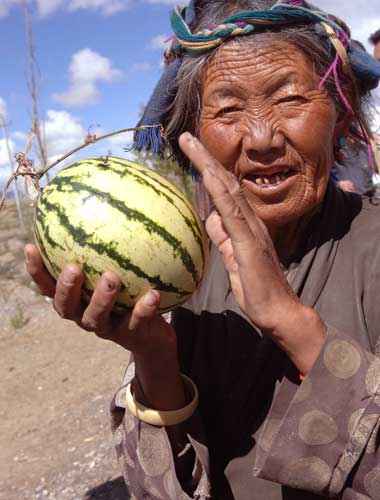
Tibetan mother in Qanggar Orchard of Nyingchi. By jogod
An overall campaign for rebuilding the road from Xinjiang to TAR is ongoing. The roads, from Tobma of Yunnan Province to Riwoche of Chamdu and from Shigatse to Lhatse on the China-Nepal road, have been completed, resulting in road accessibility to three new counties. The added electricity installed capacity is 58,000 kw. Several electricity power stations have started to operate, such as Sengye Khabap Power Station and two assembling plants in Drigung. Bahe Shokha electricity power station has begun construction, and the third agricultural network project is in full operation. An irrigation scheme is under construction in Manlha, Modar, and Yarlung; all projects are well on the way to completion, and the main project for the Gyaxong Water Reservoir has been completed.
The strategy for opening-up TAR is entering into a new phase. The Qinghai-Tibet railway and Nyingchi Airport are completely open to traffic; after resuming trade at the Netoi La Port on the China-Nepal border, export trade is increasing.
Under such social and economic circumstances, the central government is demonstrably bright about reaching the target that gross income of Tibetan farmers and herders must catch up with to match the Nation's within the 11th five-year plan. I personally believe the No.12 document issued by the central government offers effective indicators. Therefore, we have to exert much more efforts through adopting a series of strategies.
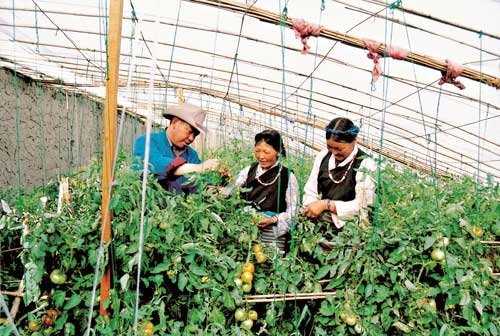
Tomato-growing green house in Bainang County. By Yang Yaming
The year 2006 is the first year we roll out the project of housing farmers and herders. In one year we have achieved much. With the input of 492 million Yuan by the government of TAR, plus 2.838 billions from other funding sources, TAR has accomplished construction of 47 thousand houses. Before the Spring Festival and in the Tibetan Calendar New Year, 257 thousand farmers and households will move into their new houses.
The civil constructions on large areas of farm and nomad land have advanced. Roads to access to 12 townships and 123 villages have already been built; 210,000 people become the newcomers to access electricity, and 320,000 people are provided with water and sanitation service; 50 central-township post offices are formally opened for rural people and 1064 villages benefit with telephone services.
At present, we have carried out 64 agriculture and animal husbandry projects with a per capita income of 660 Yuan in 2006, covering 364,000 people; 4614 cases of eye cataracts are successfully treated and the coverage rate of iodized salt reaches 35%; telephone services have already been accessed by 1.3 million households, increasing by 30.6%.
In the agriculture and animal husbandry area of TAR, all middle and primary schools are providing free tuition, including free books, notebooks, and so forth. For those boarding schools, the government also covers all costs, such as food, accommodation, and study-related costs. This provision increases annually in order to lift the financial burden from the shoulders of farmers and herders. For students in primary schools, it increases from 1000 Yuan per student per year in 2005 to 1100 Yuan in 2006; for middle school students, it reaches 1250 Yuan from 1150 Yuan in 2005; but for those students living in the border area of TAR an extra 100 Yuan per student is added.
TAR is making efforts to increase the construction of boarding schools. Currently, 67 new middle level boarding schools and 400 standardized primary township level boarding schools are set up in order to provide access to school study for 110,000 children. Apart from one county in Ngari Prefecture, the other 73 counties in TAR have already effectively implemented six years of compulsory school education, with total coverage of 99.4% of the population. 46 counties have implemented nine years of compulsory school education with 70.5% coverage of the population. 64 counties have eliminated illiteracy, and the rate of illiteracy amongst youth has decreased to 10%; the entrance rate of primary school-aged children has reached 96.5% and 82.2% for middle school-aged children.
Taking free service as a principle, the medical and health care system in TAR has already covered all farmers and herders throughout TAR. The central government and TAR local government constantly upgrades funding standards on medical and health services. In 2006, funding for per person in agricultural and animal husbandry areas has averaged 90 Yuan, being six times more than in 2000. The service to the community has improved greatly through setting up 146 new township-based health centres, expanding six county-based health centres, and increasing staffing with 302 new health workers.
At the end of the 11th five-year plan, we are going to improve the production and living standards of farmers and herders, provide roads to access townships and villages, equip them with electrical services, safe water and sanitation, housing projects, post offices covering all townships, and telephone services to village level, solve eight diseased-related problems (such as iodine deficiency-related diseases and cataracts) and solve the shortage of medical equipment at county and township level.
Qinghai-Tibet Railway Enhances the Development of Tibet
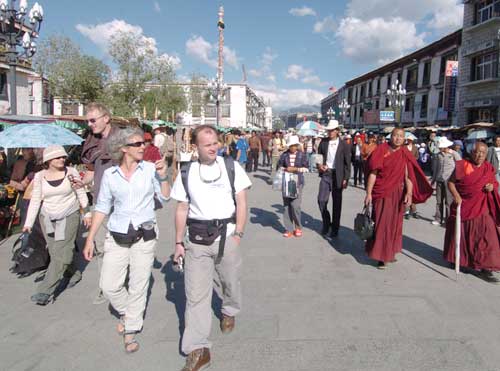
Tourists from both home and overseas are visiting the Barkor Street.
Jampa Phuntsog stresses that the Qinghai-Tibet railway has produced remarkable achievements in Tibetan social and economic development throughout its half-year operation. The railway produces a flood of people and goods. Tourist visits to Tibet reached 900 thousands at the end of June, but hit 2.45 million at the end of 2006.
Regarding the GDP increase, TAR prefers to speak of "Three wagons pulling TAR's economy? One is called "investment? another is "consumption? and the third is "imports and exports? Amongst these three, investment accounts for the biggest proportion. Since opening to traffic, the railway has not only driven economic development of Tibet but made great changes in investment patterns as well. In the past, investment came mainly from the central government and other provincial governments focusing on infrastructure constructions. But at present, along with the improvement of infrastructure, TAR is opening for further exploration, resulting in an increase in social investment and community outlook. A comprehensive investment system is formed from not only central and provincial governments, but also society and community. In addition, the relative industries, such as hotels, restaurants, communications, tourism products and handicrafts of ethnic groups, are having large benefit to development. The increase rate in total consumption reaches 17% last year, the highest rate in history.
Of course, unsolved problems remain in the tourist industry. Some of them may only exist at TAR, but others also happen in the other provinces. We have made efforts to improve the situation, but still problems remain. An example is that the construction of an information platform is incomplete. Naturally, before tourists come, they could easily get access to information by the Internet in order to be ready before setting off, such as information on where the places are and the featured food outlets there. I typically look at some Europe Countries, like Slovenia. Tourist information is provided on websites, such as where the villages are, how many and what kinds of pets are allowed, and so forth. That way, tourists could bring their pets whenever they come. Everything is booked before setting off. Nevertheless, TAR is not good at information delivery. For instance, although we have enough places to provide accommodation, tourists, people get no idea of this. They simply head to one place. Overwhelming numbers of tourists at one place makes it impossible to get accommodation and causes complaints. To set up an information-sharing platform is of great importance. In addition, we should increase hotel and infrastructures construction. It is not necessary to build five-star or four-star hotels. TAR's tourism features a big difference between peak and slack season. We prefer to focus on building medium-standard hotels so that many ordinary people could afford them. Although tourists will not reach four million, we need to be ready to encounter this number. In particular, we should pay more attention to safety issues to make tourists stay safely in Lhasa and then go back happily to where they come from.
Besides, we are thinking about how to build a favorable tourist environment in order to solve problems like sanitation and buying under coercion. After the Spring Festival, TAR is going to face another peak season of tourism. I believe, going with the acceleration of social and economic development and improvement of infrastructure in TAR, the current existing problems will soon be resolved and tourists from both home and abroad will be coming in high spirits and going back with their hearts content.
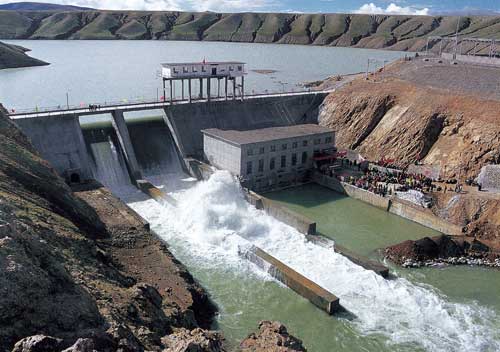
Japgang Electricity Power Station in Xainza Country services 20,000 households in the nomad area. By Yang Yaming
The construction of the railway from Lhasa to Shigatse is one of our key projects during the 11th five-year plan in TAR. Currently, the preparation of this project is progressing in an orderly and systematically way. We plan to fulfill the project's feasibility study by the end of January of 2007, carrying out preliminary design by the end of May, and formally put construction into operation. I believe that expansion of Qinghai-Tibet railway will surely bring benefits and happiness to the people living at Tsang Region of TAR, and finally bring about new changes to the snow- covered land.
Fruitful Achievements under the Cross Support System of TAR
From 1994 to now, different provinces, municipalities, central government departments, and state-owned enterprises from the hinterland have already dispatched 2893 cadres in four groups and finance totaling 9.117 billion Yuan. Support includes 2769 construction projects with 7.553 billion Yuan and 810 million Yuan converted from equipment and 763 million Yuan from other funds. The projects cover a wide scope, including improvement of living conditions of farmers and herders, infrastructure construction for the social development of cities and township, and government offices and industries. All these efforts advance the social and economic development of TAR.
For years, the central government has gradually extended its supports on finance, materials, and human resources through practicing the cross sport program in TAR. In 2001, having held "The Fourth Tibet Work Forum? the central government decided to prolong the cross support program for another ten-year so that all TAR's prefectures, cities, counties could be covered and obtained benefits. Three more provinces and 17 state-owned enterprises, one after another, join the cross support program. To take my working experience in Lhoka as an example, Hunan and Hubei Provinces were involved in this program and total eight counties were benefited from them in Lhoka. Shortly afterward, Anhui Province and China National Cereals, Oils and Foodstuffs Corp. (COFCO) were added into. Upon that, the layout of the cross support system is complete and covering all 12 counties. People make metaphorical references as: "Two lakes (Hunan and Hubei), plus a bowl (Anhui) of cooking oils (COFCO).?Besides, one more significant factor in TAR development is the contributions of cadres. Cadres play a leading role in the cross support program. The central government has chosen many excellent cadres from coastal cities and relative departments to send to TAR; some of them even take key leadership roles. We should say that those cadres have played paramount roles. Many say, due to ideological backwardness in TAR, the social and economic situation of TAR is under-developed. Apart from what the projects and funds have brought about, those cadres actually introduce new concepts and ideologies that enable the places where they are working to undergo big changes. All places welcome the cadre support projects. For this year, we have carried out the fourth groups of cadre support projects, and are going to have newcomers soon.
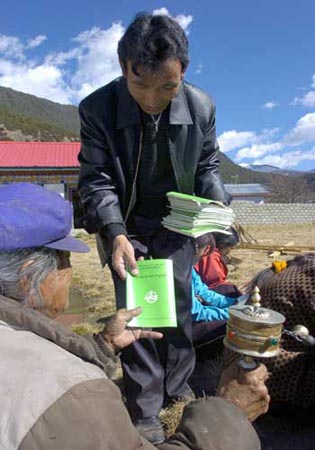
Staff of Bureau of Agriculture and Animal Husbandry,Nyingchi,are distributing an agricultural technology manual to farmers. By Yang Yaming
During the years of cross support, urban and rural areas in TAR saw remarkable changes, such as to the infrastructure of counties, roads, and so forth. Without cross support, I believe that TAR would never have accomplished such achievements in terms of great social and economic development.
Speaking of the support programs of TAR, two changes are worthy of mention here (people pay more attentions to these actually); the first one is that the support projects are sent to rural areas from urban ones. At the very beginning, almost all support projects focused on the improvement of infrastructure in urban downtowns and counties. Subsequently, Chairman Hu Jingtao specifically advanced the concept that TAR's support program should aim at rural agriculture and animal husbandry areas in order to improve the production and living standard of Tibetan farmers and herders. Since then, all investment capital has gradually expanded to rural areas and all are in successful operation now. The second change is the issue of identification of ethnic and local features in the process of operating the support program. As I know, the program, at the very beginning, didn't worry too much about local features, and this happened all over TAR. Consequently, everywhere in TAR looked well and truly brand new; however, all changes made people felt that cities and towns from the hinterland were copied to TAR. Such situation lasted a period of time, and then people started to discuss this issue and it attracted the attention of TAR's government. As a result, the situation has changed completely. I don't know if you have been to Nyingchi. In fact, it looked very common in the past, but is really beautiful now. Farmers?houses and little towns, all along the road, appear to have more ethnic characteristics than any other places. Actually, Bayi Downtown was a desolate place in the past, but now it is a clean and tidy new city featuring ethnic culture.
Preservation and Development of Traditional Culture
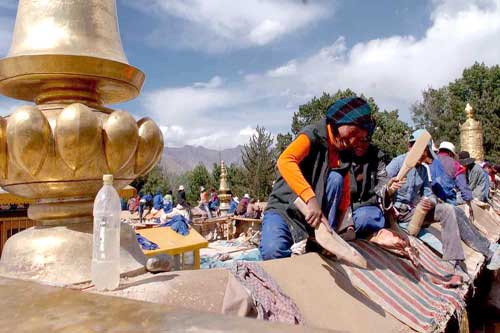
Tibetan workers are repairing a wall in the Norbulingka.
Our fine traditional culture is an important cultural resource of TAR, and it is also an asset for Tibetan development.
For the sake of further strengthening the preservation of Tibetan fine traditional culture, since last year TAR has launched a full-scale non-cultural heritage preservation program, involving in 15 projects. Twenty-three non-cultural heritages items enter the first list of state-level preservation by the State Department. At present, TAR has already established organizations at different levels for preservation of non-cultural heritages. In this year, TAR is going to provide four million Yuan to conduct a comprehensive survey of Tibetan non-cultural heritages and then work out a corresponding plan for preservation.
To preserve and develop our fine traditional culture is a prerequisite to realize the sustainable development of TAR. By all means, we will not allow ecosystem and resource damage for the sake of simply pursuing development. For instance, tourists visiting the Potala Palace do so in controlled numbers everyday. All in all, the Palace is a wood-stone building. Too many visitors at one time will surely cause negative impacts on the preservation of the whole building. Of course, it is pity if people coming from far away could not get chance to visit. We are thinking about a way to cope with this and may open the exhibition of Shol Village under the Potala Palace.
Many facts demonstrate that traditional culture will definitely not be destroyed but rather benefit by self-preservation if we take a rational approach to develop and utilize it. For example, in recent year TAR applied strategies to develop Tibetan medicine and pharmacology, silver handcrafts and carpets, Thangka, incense, Tibetan opera, and folk dance and songs. Utilization of traditional Tibetan culture not only advances the development of Tibetan tourism, but also increases its prosperity; many traditional arts, being in imminent danger, rise again through preservation.
I personally believe that culture should not be identified as an only a sample preserved and displayed in a museum, but rather given a dynamic status. Definitely, Tibetan culture is not a fossil, zoology, and a reservation. Upon that, Tibetan culture ought to take its place in change and development. After decades, we have found that Tibetan culture would be surely and mutually beneficial if we pay more attention to the preservation and development of traditional Tibetan culture and integrate the traditional culture with a modern one. The more people understand the cultural features (including its geographical characteristics), the more brilliant and successful the culture becomes, and the more the culture acts automatically to continue and preserve itself. Affirmatively speaking, Tibetan culture was never as prosperous as it today. One example I would like to give is the Lhatse Farmer Dance and Singing Group that got a rather wonderful reception after they showed up in Beijing. Just when they finished their performance on that day, many calls came to me. The first one was from Mr. Radi, the vice Chairman of the PRC National People's Congress. He said the performance of this group was really gorgeous, and it was necessary to further promote Tibetan cultural features and bring them to a great height of development. He also mentioned that it was important to push such cultural assets into markets, and it showed a good trend to make cultural industrialization possible.
At present, it is easy to see that there are many kinds of Tibetan performance, be they in Tibetan hotels or restaurants or other entertainments. It attracts many foreigners. It is regretted that many people still doubt if our performers are Tibetans. As matter of fact, wherever Tibetan performances are staged, be they formal performances on stage by formal performance groups or at entertainments of original Tibetan dance and singing, Tibetans perform them themselves. This is actually the tradition of Tibet as inherited throughout history.
I think that the more people come to Tibet, the more they will enjoy Tibetan culture, and the further Tibetan traditional culture will be developed. Such kinds of claims-"Tibetan cultural has been destroyed?by the Dalai clique-are complete nonsense. And any worries about the disappearance of Tibetan culture are irrational.
Taking Barkor Market as one example, if we only take it as a relic, it is old-fashioned; while keeping its original external appearance, we updated its inner structure carefully, such as washing rooms. Those heritage sites, such as the street from the market building to Jokhang Monastery, are decorated properly with minimal cost but making them more attractive. In this year, we are planning to renovate the surrounding areas of the old downtown in Lhasa.
I would rather do my best for the masses
In 1947, I was born in downtown Chamdu. At the beginning, I had studied at a private school for several years, and then moved to Chamdu Primary School in 1956. Modern education had started earlier in Chamdu than any other places in Tibet in wake of an earlier liberation. During that period, schools were rather few but with a high quality of education; even some professors to run classes. The Cultural Revolution caused children to dropout from schools. In October of 1970, I was employed by the Agriculture Machinery Factory and performed various kinds of jobs there. From 1972, I spent my four years to study in the Machinery Department of Chongqing University, and then served as technician in the Agriculture Machinery Factory in TAR. I have since undertaken such posts as director of the workshop, and then director of the factory with a staff of about 200 to 300 people.
Going with the fashion of agricultural mechanization, I was promoted to Vice-Director of the Bureau of Agricultural Machinery and then moved to Pome County as party secretary. In 1983, I came to Chamdu Prefecture and had acted as vice governor of the prefecture for over 10 years. My superiors required me to move out of Chamdu and work in other prefectures. I disagreed because my mother was not healthy and my own stomach was also not in good condition in those years. Shortly afterward, the situation changed for the better and I was moved and worked at Lhoka prefecture for another five years (as prefecture governor in two and half years and party secretary for other two and half years). Then I was posted as the party secretary of Lhasa Municipality and have been working there until now.
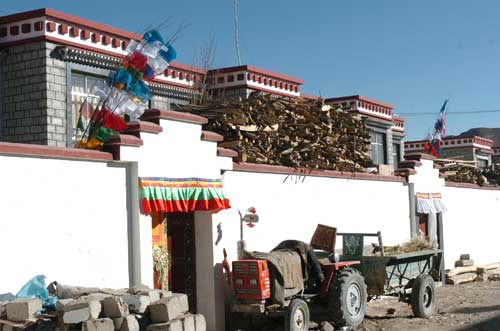
Over 257 thousand Tibetans have moved to new houses in the New Year of 2007. By Jogod
When I was in Canada, some foreigners questioned me as to why I claimed I could speak on behalf of Tibetan people. I told them firstly I came from the very basic grassland (the true community) of TAR. I have experienced and felt the community throughout my career until today. Secondly, speaking of elections, I informed them about how our people??s congress preceded its election, how I was chosen, what my election results were, and why it was not the Dalai Lama in their opinion. All my words rendered them speechless.
What I am today is mainly attributed to the influence of the CCP. In 1947, my mother gave me birth, but she could not remember the exactly day. I joined in the party as a member on the sixth of May. Since that, I chose this day as my birthday. I believe that what I have achieved is something I would never have dreamed to be. People like me get no background support due to my parents being common people and they cannot even speak one word of Chinese. But I was sent to university to study on those days. And then I rose to a senior leader from a general technician under the care of the party. I should say that if there were not the party, I would not be myself today. To remember what I have gone through, I could come to the conclusion that this is the road taken by all cadres of ethnic Tibetans on which the party takes care of us during our youth. This is also the history of ethnic Tibetans becoming their own masters.
Of course, personally speaking, I myself am never in pursuit of getting promotion. I have experienced so many posts in the past. I always work studiously to do my best. I didn't even know I was a candidate for Chairman of the government when the superior departments designated people to come here for review. When they asked me for my personal information, I told them my health was not good enough. A person later on told me he had interviewed many candidates for different posts in past, people always told him that their health was good and he felt that I was different. My aim is not to make efforts get promotion but rather do my best for the masses through a pragmatic approach wherever I am posted to different positions. It is because I fully understand the masses, their needs, difficulties, and wishes. The central government, lead by Hu Jingtao as the general secretary of the party, also told us that the needs of the masses were what all of us must take into our consideration. I see this as the historical phase of revival of the Chinese nationalities. It is my responsibility to do some beneficial works for our masses by exploiting the current advantages and also my own competence.
As the chairman of the government of TAR, I understand completely the significance of my responsibility and accountability, and I know what the responsibility is on my shoulders, but I prefer to do my utmost by using my knowledge and competence to make possible the changes to TAR in terms of stability, sustainable development, wealth and prosperity.
Lastly, Jampa Phuntsog requested the reporters of China's Tibet to travel around TAR frequently so that they could experience the rapid development happening in TAR. By traveling around, the reporters could feel what TAR is practicing on the way to building a better society. Of course, reporters could also experience the most charming landscape, the unadorned and richest culture, and the people of TAR in order to better introduce Tibet to outsiders.